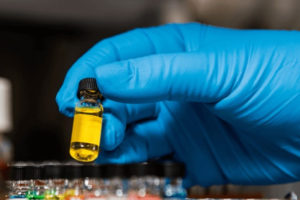About the client
The client is a clinical-stage pharmaceutical company dedicated to developing and commercializing proprietary therapeutics that modulate lipid-signalling pathways. The company is advancing a portfolio of broadly applicable product candidates designed to address significant unmet needs in multiple diseases and conditions, including anorexia, cancer, anxiety, dermatologic conditions, pain, and inflammation.
The requirement
The pharma company was searching for a partner who could undertake IND-enabling safety tox studies for their molecule for submission to the US FDA.
The molecule was the lead compound in the company’s proprietary fatty acid-binding protein platform. The protein target is an intracellular protein involved in lipid signalling and represents a promising mechanism of action for drug candidates that can modify the cellular lipidome.
The molecule was being developed as a non-opioid approach to managing painful neuropathies. It sought to address a critical need in painful neuropathies, including chemotherapy-induced peripheral neuropathy for which there is no FDA-approved treatment.
The challenge
The company partnered with us after evaluating our capabilities, scientific expertise, and experience in supporting IND-enabling tox package. However, the challenge was to complete the long list of GLP Tox studies in less than nine months while maintaining stringent quality standards.
The IND package included the following studies:
• Safety pharmacology studies, including effect on the central nervous system, cardiovascular effects, and respiratory effects
• 35-day repeat dose general toxicity studies in two animal species
• Genotoxicity assessment
• Analytical and bioanalytical validation studies
The solution
Our safety assessment team worked proactively to execute all the studies on time. While conducting these studies, we encountered several issues which we resolved promptly and effectively by collaborating with cross-functional teams.
Initially, we conducted studies on rats and dogs to gather necessary PK and metabolism data. Next, the analytical team characterized test articles as per GLP standards. This was followed by the selection of appropriate vehicles and analytical validation for formulation and TK matrix. Next, doses for GLP studies were selected based on DRF studies. Different GLP studies were conducted in parallel where possible to reduce the overall timelines. We also undertook adequate and clear documentation including CTD-compliant reports and toxicology data as per the IND package guidelines. Finally, we helped put together SEND dataset as per FDA standards for IND submission.
Conclusion
We supported the pharma company by delivering all safety assessment studies (GLP package) required to progress the molecule to the IND phase. Studies included exploratory and GLP studies such as genotoxicity, rodent and non-rodent toxicology, safety pharmacology studies, and preparing the SEND dataset per FDA data standards. As a result, the company could submit their IND application to the FDA in a record time of nine months.
The pharma company has since received IND clearance from the FDA to initiate clinical trials for chemotherapy-induced peripheral neuropathy. Phase-1 trial results are expected in the first half of 2025.
The pharma company greatly appreciated the technical expertise and responsiveness of our scientists in accelerating their molecule’s progression to the IND phase. We continue to remain their key partner for all toxicology and safety pharmacology assessment studies for forthcoming projects as well.
To know more about our safety assessment services, contact our experts.







